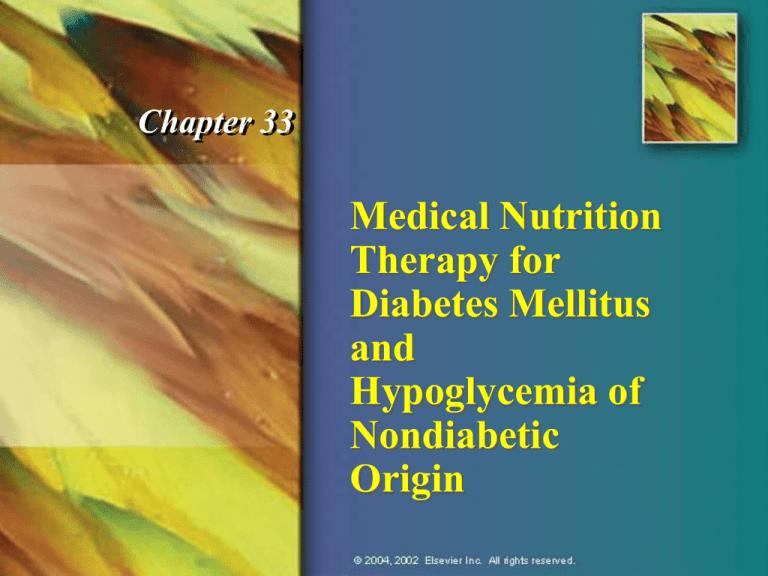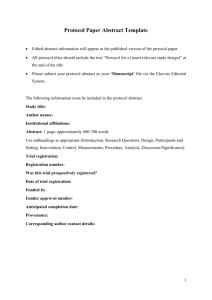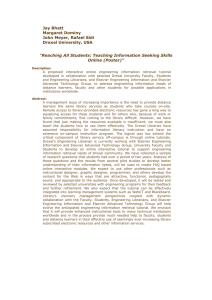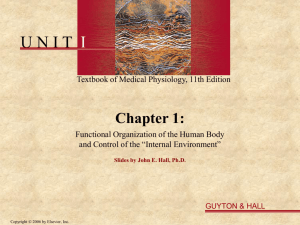
Chapter 33
Medical Nutrition
Therapy for
Diabetes Mellitus
and
Hypoglycemia of
Nondiabetic
Origin
Diabetes Mellitus
Definition
A group of diseases characterized by high
blood glucose concentrations resulting from
defects in insulin secretion, insulin action, or
both
© 2004, 2002 Elsevier Inc. All rights reserved.
Diabetes and Prediabetes
Types
Type 1 (formerly IDDM, type I)
Type 2 (formerly NIDDM, type II)
Gestational diabetes mellitus (GDM)
Prediabetes (impaired glucose homeostasis)
Other specific types
© 2004, 2002 Elsevier Inc. All rights reserved.
Diabetes
Type 1
Two forms
– Immune mediated—beta cells destroyed by
autoimmune process
– Idiopathic—cause of beta cell function loss
unknown
© 2004, 2002 Elsevier Inc. All rights reserved.
Diabetes
Type 2
Most common form of diabetes accounting for
90% to 95% of diagnosed cases
Combination of insulin resistance and beta cell
failure (insulin deficiency)
Progressive disease
© 2004, 2002 Elsevier Inc. All rights reserved.
Prediabetes
(Impaired Glucose Homeostasis)
Two forms
– Impaired fasting glucose (IFG)—
fasting plasma glucose(FPG) above
normal
– Impaired glucose tolerance (IGT)—
plasma glucose elevated after 75 g glucose
load
© 2004, 2002 Elsevier Inc. All rights reserved.
Gestational Diabetes Mellitus
(GDM)
Glucose intolerance with onset or first
recognition during pregnancy
© 2004, 2002 Elsevier Inc. All rights reserved.
Diabetes—Symptoms
General
Type 1
Hyperglycemia
Ketonuria
Glycosuria
Acetone breath
Polyuria
Acidosis
Polydipsia
Weight loss
Dehydration
Polyphagia
© 2004, 2002 Elsevier Inc. All rights reserved.
Type 1 Diabetes—Cause
Algorithm content developed by John Anderson, PhD, and Sanford C. Garner, PhD, 2000.
© 2004, 2002 Elsevier Inc. All rights reserved.
Type 1 Diabetes—Pathophysiology
Algorithm content developed by John Anderson, PhD, and Sanford C. Garner, PhD, 2000.
© 2004, 2002 Elsevier Inc. All rights reserved.
Type 1 Diabetes—Medical and Nutritional
Management
Algorithm content developed by John Anderson, PhD, and Sanford C. Garner, PhD, 2000. Updated by Marion J. Franz, 2002.
© 2004, 2002 Elsevier Inc. All rights reserved.
Metabolic Syndrome
Characteristics
Insulin resistance
Compensatory hyperinsulinemia
Abdominal obesity
Dyslipidemia (elevated TG, low HDL)
Hypertension
Risk factor for cardiovascular disease and glucose
intolerance
© 2004, 2002 Elsevier Inc. All rights reserved.
Type 2 Diabetes—Cause
Algorithm content developed by John Anderson, PhD, and Sanford C. Garner, PhD, 2000.
© 2004, 2002 Elsevier Inc. All rights reserved.
Type 2 Diabetes—Pathophysiology
Algorithm content developed by John Anderson, PhD, and Sanford C. Garner, PhD, 2000.
© 2004, 2002 Elsevier Inc. All rights reserved.
Type 2 Diabetes—Medical and Nutritional
Management
Algorithm content developed by John Anderson, PhD, and Sanford C. Garner, PhD, 2000. Updated by Marion J. Franz, 2002.
© 2004, 2002 Elsevier Inc. All rights reserved.
Methods of Diagnosis
Fasting plasma glucose (FPG)
Casual plasma glucose (any time of day)
Oral glucose tolerance test (OGTT)
© 2004, 2002 Elsevier Inc. All rights reserved.
Criteria for Diagnosis
FPG
mg/dl
Normal
<110
OGTT
2 hr
mg/dl
<140
Prediabetes
>110 and
< 126
>140 and
<200
Diabetes
>126
>200
© 2004, 2002 Elsevier Inc. All rights reserved.
Casual PG
mg/dl
>200 +
symptoms
Who Should Be Screened for DM?
Persons >45 years; repeat every 3 years
Younger age; screened more frequently
Overweight (BMI >25)
First-degree relative with diabetes
High-risk ethnic population
Delivered baby >9 lb or diagnosed GDM
Hypertensive
HDL <35 mg/dl or TG >200
Prediabetes
Polycystic ovary syndrome
© 2004, 2002 Elsevier Inc. All rights reserved.
Pathophysiologic Complications
of Type 1 Diabetes Mellitus
Ketoacidosis
Macrovascular disease
Microvascular disease
—Retinopathy
—Nephropathy
Neuropathy
© 2004, 2002 Elsevier Inc. All rights reserved.
Pathophysiologic Complications
of Type 2 Diabetes Mellitus
Abnormal pattern of insulin secretion and
action
Insulin resistance causing decreased cellular
uptake of glucose
Increased gluconeogenesis and hepatic glucose
release
© 2004, 2002 Elsevier Inc. All rights reserved.
Insulin Counterregulatory Hormones
Glucagon
Epinephrine (adrenaline)
Norepinephrine
Cortisol
Growth hormone
© 2004, 2002 Elsevier Inc. All rights reserved.
Diabetes—Treatment Goals
FPG 90—130 mg/dl
Hemoglobin A1c <7%
© 2004, 2002 Elsevier Inc. All rights reserved.
Oral Glucose-Lowering Medications
Drugs, administered orally, that are used to
control or lower blood glucose levels, including
first- and second-generation sulfonylureas,
nonsulfonylurea secretagogues, biguanides,
alpha-glucosidase inhibitors, and
thiazolidinediones
© 2004, 2002 Elsevier Inc. All rights reserved.
Oral Glucose-Lowering
Medications—cont’d
Sulfonylureas
—Stimulate insulin secretion from beta cells
Meglitinide
—Stimulates insulin secretion from beta cells
Biguanide
—Decreases hepatic glucose production and increases
insulin secretion
Thiazolidinediones
—Improve peripheral insulin sensitivity
Alpha glucosidase inhibitor
—Delays carbohydrate absorption
© 2004, 2002 Elsevier Inc. All rights reserved.
Action Times of Human Insulin
Regimens
Insulin
Onset
Peak
Duration
Rapid acting
<15 min
0.5–1.5 hr
2–4 hr
0.5–1 hr
2–3 hr
3–6 hr
2–4 hr
6–10 hr
10–16 hr
6–10 hr
10–16 hr
18–20 hr
0.5–1 hr
Dual
10–16 hr
(Lispro, Aspart)
Short acting
(Regular)
Intermediate
(NPH)
Long acting
(Ultralente)
Mixtures
© 2004, 2002 Elsevier Inc. All rights reserved.
Estimating Minimum Energy
Requirements for Youth
Base energy requirements on food and nutrition
assessment
Validate energy needs
Toddlers
© 2004, 2002 Elsevier Inc. All rights reserved.
Diabetes Prevention
Moderate weight loss (5%–7% body weight)
Regular physical activity
Low-fat diet (30% of energy intake)
Structured programs with regular participant
contact
© 2004, 2002 Elsevier Inc. All rights reserved.
Types of Hypoglycemia
Postprandial hypoglycemia
Alimentary hyperinsulinemia
Idiopathic reactive hypoglycemia
Fasting hypoglycemia
Factitious hypoglycemia
© 2004, 2002 Elsevier Inc. All rights reserved.
Goals of Medical Nutrition Therapy
for Diabetes
Maintenance of as near normal BG levels as
possible, by balancing food, medication, and
physical activity
Achievement of optimal serum lipid levels
Provision of adequate calories for maintaining
or attaining reasonable weight in adults, normal
growth/development in children and
adolescents, increased metabolic needs in
pregnancy and lactation, or recovery from
catabolic illnesses
© 2004, 2002 Elsevier Inc. All rights reserved.
Goals of Medical Nutrition Therapy
for Diabetes—cont’d
Prevention and treatment of the acute or
chronic complications of diabetes
Improvement of overall health through optimal
nutrition using the Dietary Guidelines for
Americans and the Food Guide Pyramid
© 2004, 2002 Elsevier Inc. All rights reserved.
Basic Strategies for Type 1 Diabetes
Meal plan should be based on assessment of
patients usual food intake.
Integrate insulin therapy into the usual eating
and exercise patterns.
Conventional therapy requires eating at
consistent times synchronized with the action of
insulin.
Intensified therapy allows more flexibility in
timing and amount of food eaten.
© 2004, 2002 Elsevier Inc. All rights reserved.
Basic Strategies for Type 2 Diabetes
Encourage weight loss.
Moderate calorie restriction (250–500 kcal/day
less) is associated with improved control
independent of weight loss.
Spread nutrient intake, especially carbohydrate
(CHO) throughout the day.
Encourage physical activity.
Decrease fat intake.
Monitor BG, and add medications if needed.
© 2004, 2002 Elsevier Inc. All rights reserved.
Food Guide Pyramid
Use basic guide
Use diabetes-specific guide
© 2004, 2002 Elsevier Inc. All rights reserved.
Recommendations for Weight
Management
Make permanent changes in eating behavior.
Eat regularly.
Slow, gradual weight loss is best.
Choose lower-fat foods.
Incorporate regular physical activity.
© 2004, 2002 Elsevier Inc. All rights reserved.
Protein
Provides 4 kcal/g
10% to 20% of total kcal
0.8 g/kg (note: this is the RDA for the general
population) is recommended for clients with
microalbuminuria. This is feasible with regular
foods.
Once GFR begins to fall, some recommend 0.6
g/kg; this will likely require special lowprotein foods and nutrition deficiency is
possible.
Animal vs plant
© 2004, 2002 Elsevier Inc. All rights reserved.
Fat
Provides 9 kcal/g
General recommendation of <30% of total kcal
and saturated fat <10% of total calories applies
to people with DM who have normal lipid
levels and a reasonable body weight.
If client is obese or has elevated lipid levels,
further reduction combined with physical
activity should be considered.
If LDL is primary problem, use the NCEP Step
II diet (saturated fat <7% of total calories).
© 2004, 2002 Elsevier Inc. All rights reserved.
Carbohydrate
Provides 4 kcal/g
Total carbohydrate consumed is more
important than the source of the carbohydrate.
Daily total and distribution should be
individualized and based on each client’s
habits and blood glucose and lipid goals.
© 2004, 2002 Elsevier Inc. All rights reserved.
Action of Insulin on Carbohydrate, Protein, and
Fat Metabolism
© 2004, 2002 Elsevier Inc. All rights reserved.
Sucrose
Numerous studies in which sucrose was
substituted for starch found no adverse effect
on glycemia.
Sucrose and sucrose-containing foods must be
substituted for other carbohydrates and not
simply added to the meal plan.
Still important to recommend caution because
foods containing sucrose generally contain
minor amounts of vitamins and minerals and
tend to be higher in fat
© 2004, 2002 Elsevier Inc. All rights reserved.
Nutritive Sweeteners
Include fructose, honey, corn syrup,molasses,
fruit juice, dextrose, maltose, mannitol,
sorbitol, xylitol, and hydrogenated starch
hydrosylates as well as sucrose
Research has shown no significant advantage
or disadvantage of any of these over sucrose.
Large amounts of fructose may increase
cholesterol levels.
Sugar alcohols in large amounts cause osmotic
diarrhea.
© 2004, 2002 Elsevier Inc. All rights reserved.
Nonnutritive Sweeteners
Include aspartame, acesulfame K, sucralose,
and saccharin
All can be safely used by people with diabetes
mellitus.
Average intake of aspartame is 2 to 4
mg/kg/day, whereas the ADI is 50 mg/kg/day
ADI of acesulfame K is 15 mg/kg, which is the
equivalent of a 60 kg person eating 36
teaspoons of sugar daily
© 2004, 2002 Elsevier Inc. All rights reserved.
Fiber
Same recommendation as the general public—
20 to 35 g/day. Increase gradually and make
sure they have adequate water intake.
Beneficial in maintaining normal GI function
and treating or preventing several benign GI
disorders and colon cancer
Although selected soluble fibers are capable of
delaying glucose absorption, the effect on
glycemia is probably insignificant.
Large amounts of soluble fiber may have a
beneficial effect on serum lipids
Provide satiety value
© 2004, 2002 Elsevier Inc. All rights reserved.
Sodium
Association between hypertension (HTN) and
both types of diabetes mellitus (DM)
Same intake as general population is
recommended for otherwise healthy people
with DM—less than 3000 mg/day
For people with mild HTN and diabetes—
should have less than 2400 mg/day
For people with more serious HTN or
edematous clients with nephropathy
recommend 2000 mg/day or less
© 2004, 2002 Elsevier Inc. All rights reserved.
Lipid Goals
Cholesterol
<200 mg/dl
LDL cholesterol
<100 mg/dl
HDL cholesterol
Men
>45 mg/dl
Women
>55 mg/dl
Triglycerides
© 2004, 2002 Elsevier Inc. All rights reserved.
<150 mg/dl
Blood Pressure Goals
Systolic
<130 mm Hg
Diastolic
<80 mm Hg
© 2004, 2002 Elsevier Inc. All rights reserved.
Alcohol
In a fasting state ETOH may produce
hypoglycemia, and this effect can persist for 8
to 12 hours after the last drink.
Can’t be converted to glucose; inhibits
gluconeogenesis
© 2004, 2002 Elsevier Inc. All rights reserved.
Alcohol Guidelines for Insulin Users
Limit to no more than two drinks per day
Drink only with food
Do not cut back on the amount of food eaten..
Abstain if history of ETOH abuse and during
pregnancy or lactation or if there are possible
interactions with other medications
© 2004, 2002 Elsevier Inc. All rights reserved.
Alcohol Guidelines for Noninsulin
Users
Substitute for fat calories
Limit to promote weight loss or maintenance
Limit if triglycerides are elevated
Abstain if history of ETOH abuse and during
pregnancy or lactation, or if there are possible
interactions with other medications
© 2004, 2002 Elsevier Inc. All rights reserved.
Micronutrients
Vitamin/mineral needs of people with diabetes
who are healthy appear to be adequately met
by the RDAs.
Those who may need supplementation include
those on extreme weight-reducing diets, strict
vegetarians, the elderly, pregnant or lactating
women, clients with malabsorption disorders,
congestive heart failure (CHF) or myocardial
infarction (MI)
Chromium and magnesium are beneficial only
if the client is deficient.
© 2004, 2002 Elsevier Inc. All rights reserved.
Food Adjustments for Special
Situations
Illness
Exercise
Hypoglycemia
Pregnancy
Ethnic or cultural differences
© 2004, 2002 Elsevier Inc. All rights reserved.
Four-Pronged Approach to Diabetes
Medical Nutrition Therapy
Comprehensive nutrition assessment
Set goals with the client
Nutrition intervention
Evaluation
© 2004, 2002 Elsevier Inc. All rights reserved.
Nutrition Intervention
Dietary Guidelines
for Americans
Single-topic diabetes
resources
Guide to good eating
Food Guide Pyramid
Individualized
menus
Month of meals
Exchange lists for
meal planning
The first step in
diabetes meal
planning
Healthy food choices
CHO counting
Healthy eating
Calorie counting
Fat counting
© 2004, 2002 Elsevier Inc. All rights reserved.





